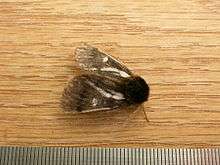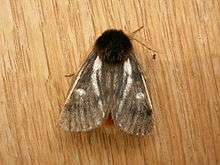Ochrogaster lunifer
| bag-shelter moth | |
|---|---|
 | |
 | |
| Scientific classification | |
| Kingdom: | Animalia |
| Phylum: | Arthropoda |
| Class: | Insecta |
| Order: | Lepidoptera |
| Family: | Thaumetopoeidae |
| Genus: | Ochrogaster |
| Species: | O. lunifer |
| Binomial name | |
| Ochrogaster lunifer Herrich-Schäffer, 1855 | |
Ochrogaster lunifer (the bag-shelter moth, also known as the processionary caterpillar), is a member of the family Thaumetopoeidae. Both the larval and adult forms have hairs that cause irritation of the skin (urticaria). The adult moth has a woolly appearance and its wings can grow to be about 5.5cm across. The larvae feed on Grevillea striata at night and reside in brown silken bag nest during the day.[1]
Behaviour
During the day the caterpillars shelter communally in a bag nest made of silk, excrement, shed skins, and other debris. Sometimes the nest is located on a shoot at the end of a branch, or sometimes high on the trunk. It can also be on the ground at the base of the food plant. The different nesting habits suggest that there may be two or more species currently being included under the Ochrogaster name.[2]
The caterpillars feed mostly on acacia (wattle) trees and Grevillea striata (Beefwood). If they have totally defoliated their food tree, the caterpillars migrate to seek out another one, leaving a silk trail. When a caterpillar of the species encounters such a trail it will follow it, especially if there is a pheromone scent associated with it. There can be a hundred or more caterpillars in a head-to-tail procession, kept together by contacting the tail hairs of the caterpillar in front. If disturbed, they curl up defensively into a tight bunch.[2]
If two caterpillars each locate a silk trail left by the other, the pair will follow each other, and so will walk around in a circle. If a whole group does this, then they can end up in a circular mass.
When mature, the caterpillars seek out a place somewhere distant from their food plant to pupate, again leaving a silk trail as they walk. The pupa is hidden in a silk cocoon in the ground.[2]
The caterpillars emerge from the pupa as a moth with a wingspan of up to 5.5 cm. The forewings are dark grey or brown, and the hindwings are white shading to grey at the base. Some moths have a pale dot in the centre of each forewing and some have white lines across the wings. They have a banded abdomen which ends in a white tuft of hairs. The variety of their markings also suggests that there might be more than one species present in Australia.[2]
Medical significance
The caterpillar larvae are covered in fine, venomous spines which contain a potent anticoagulant as the animals primary defense mechanism.
Gallery
 Mounted adult, dorsal view
Mounted adult, dorsal view Mounted adult, ventral view
Mounted adult, ventral view Ochrogaster lunifer curling up into a ball for protection
Ochrogaster lunifer curling up into a ball for protection- Larva
 Travelling in a line
Travelling in a line Travelling in a line
Travelling in a line
See also
- Comparison of butterflies and moths
- Notodontidae, under which Thaumetopoeidae can be a subfamily.
- Thaumetopoeidae family (processionary moths)
References
- ↑ "Ochrogaster lunifer". Discover Nature at JCU. James Cook University. Retrieved 2016-05-25.
- 1 2 3 4 Herbison-Evans, Don; Crossley, Stella. "Ochrogaster lunifer". Butterfly Encyclopedia. Coffs Harbour Butterfly House. Retrieved 2016-05-25.
| Wikimedia Commons has media related to Ochrogaster lunifer. |